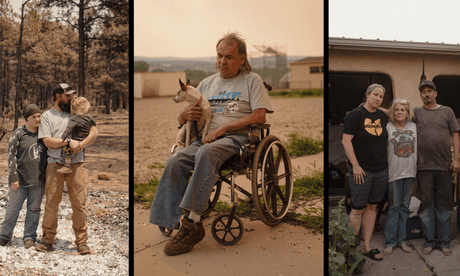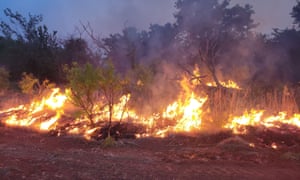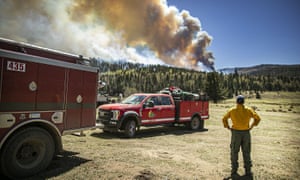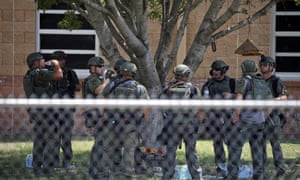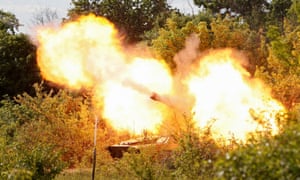Predicted wind gusts could cause fire to jump containment lines as crews in New Mexico try to stop growth of US’s biggest wildfire.
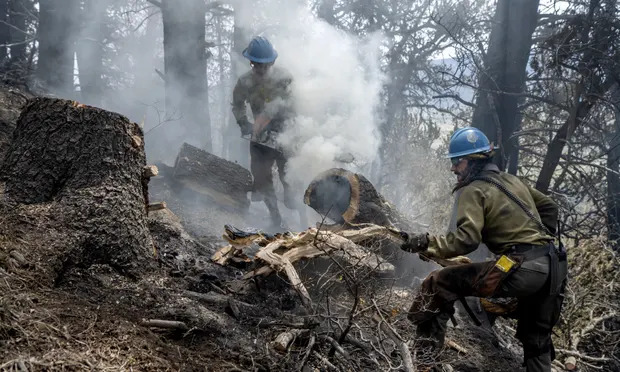 Crews in northern New Mexico cut and clear containment lines around nearly half of the perimeter of the nation’s largest active wildfire. Photograph: Eddie Moore/AP – May 23.
Crews in northern New Mexico cut and clear containment lines around nearly half of the perimeter of the nation’s largest active wildfire. Photograph: Eddie Moore/AP – May 23.
Associated Press
–
Warnings of critical fire conditions are peppered across much of the US south-west this weekend, as crews in northern New Mexico worked to stop the growth of the nation’s largest active wildfire.
Two fires that merged to create the largest wildfire in New Mexico history have both been traced to planned burns set by federal forest managers as preventative measures, federal investigators have announced.
The seven-week-old fire has burned 491 sq miles of forest in rugged terrain east of Santa Fe since being started in April by two intentional blazes set by the authorities.
Crews were patrolling partially burned areas and clearing and cutting containment lines, including primary ones near the fire this weekend as bulldozers scraped backup lines farther away.
The National Weather Service issued red flag warnings of critical fire conditions for parts of Arizona, Colorado, Kansas, Nevada, New Mexico, Oklahoma, Texas and Utah. Those conditions are combination of strong wind, low relative humidity and dry vegetation.
The return of drier and warmer weather with stronger winds posed a threat of increased fire activity into the Memorial Day holiday on Monday, prompting officials to urge the public to secure tow chains on the backs of their vehicles, which can send up sparks if they drag on the road, and be extra careful with any other possible fire sources.
“The last thing we need right now is another ignition,” said Jayson Coil, an operations section chief.
Forecasts predict wind gusts up to 50mph, with critical fire conditions continuing into Monday, followed by more favorable weather later in the coming week, said Bruno Rodríguez, the fire management team’s meteorologist.
The strong winds could fan flames and cause the fire to jump containment lines and race forward, said John Chest, a fire operations manager.
“Imagine traveling in your car and the fire can outpace you. That’s the kind of extreme fire behavior that we’re talking about,” Chest said.
Nearly 3,000 firefighters and other personnel were assigned to the fire, which was contained around 48% of its perimeter.
Initial estimates say the fire has destroyed at least 330 homes but New Mexico state officials expect the number of homes and other structures that have burned to rise to more than 1,000 as more assessments are done.
The US Forest Service has not yet released detailed planning documents for the original planned burns that might indicate whether fire protocols were followed.
Scientist and forest managers are racing to develop new tools to forecast the behavior of planned fires amid climate change and an enduring drought in the American west.
The intentionally set blazes, known as prescribed burns, are aimed at limiting the accumulation of timber and underbrush that, if left unattended, can fuel extremely hot and destructive wildfires.
Elsewhere, firefighters battled a wind-driven bushfire about 14 miles south-west of Parker, Arizona. A California blaze jumped the Colorado River into Arizona on Saturday.
–
Topics
Related stories
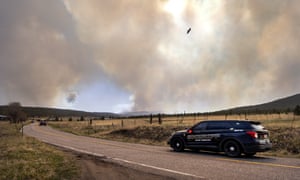
–
Most viewed









